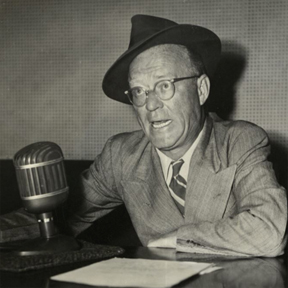In the early days of television, viewers used to see graphics like the one shown here. The “technical difficulties” test pattern would often be accompanied by an annoying humming whistle tone, which meant – we imagined – that technicians in lab coats were furiously scrambling to unscramble the television signal.
The TV day began with a test pattern, too. Bold lines and mysterious designs hovered on screen for long minutes suggesting electronic gadgets were being warmed up and images aligned for proper viewing. Television stations signed on at daybreak and off at 11 or 12 o’clock at night. The National Anthem was played to end the broadcast day.

WNCT in Greenville was the first station to reach Craven County with a signal. An affiliate of the Columbia Broadcasting System (CBS), it began airing in 1953 on Channel 9. Suddenly, a “television set” was a status symbol and living room crowds swelled when the host invited lucky neighbors or relatives over to view the newfangled novelty.
Local Channel 9 was followed in 1955 by WITN on Channel 7 from Washington (actually Chocowinity). In addition to area programming, WITN carried news and shows from NBC, the National Broadcasting Corporation.
The TV western – Gunsmoke, The Lone Ranger, Rawhide, and Have Gun, Will Travel – became an entertainment staple while comedy shows, some of them broadcast live, vied for audience attention. Melodramatic romance sagas, aimed primarily at the era’s legion of “homemakers,” dominated daytime programming. Sponsors hawked laundry detergent and other household items and the shows quickly earned the nickname “soap operas.”
Later into the game was Channel 12. WNBE in New Bern was a part of the American Broadcasting Corporation (ABC). It appeared on monochrome television screens in Vanceboro, New Bern, Havelock, Newport, Morehead City and elsewhere in September 1963 just two months before the ground-breaking wall-to-wall news coverage around the assassination of President John Kennedy.

Waldemar E. Debnam Papers (#426),
Joyner Library, East Carolina University
The application for a New Bern channel 13 had actually been filed in 1954. Nathan Frank of Henderson had to battle objections from the military about a proposed 1,000-foot-tall transmission tower and from other stations about signal overlap. He was finally granted WNBE as “Channel 12” in 1961 after a seven-year struggle.
When WNBE began airing two years later, its first programming was one movie after another for many days, a rare format and much to the delight of the local viewing audience. WNBE’s call sign, which was a sort of abbreviation for “New Bern,” was switched to WCTI in 1970.

In the 1950s when newspapers were dominant, TV networks provided just 15 minutes – and later a half hour – of “nightly news” around 6:00 p.m. Local news came morning-to-midday from hosts like W.E. Debnam. Debnam appeared daily on WNCT beginning in 1956 before moving to WITN in 1963. In a time before air conditioning, Debnam Views the News would sometimes be briefly interrupted while the star announcer dispatched a worrisome housefly with the fly-swatter he routinely kept lying on his studio desk.
Among the first programs, boxing and baseball claimed the men. Sky King, Alfred Hitchcock, Dragnet and I Love Lucy entertained the whole families. The kids were lured by Howdy Doody, Lassie and Leave it to Beaver. A weekly TV Guide subscription was a must-have.

Before the advent of cable, three often-snowy black-and-white channels were all the TV available in Craven and surrounding counties. And before remote controls, children were often the channel changers of choice for mom and dad.
by Edward Ellis, Special Correspondent
Eddie Ellis is the author of New Bern History 101 and other works about Craven County’s rich heritage. He can be reached at flexspace2@aol.com.
More at edwardellis.com

